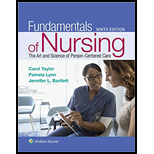
Concept explainers
To discuss:
The evidence point to as “best practice” for the patient Mr. S?
Case summary:
The nursing student is caring for a 68-year-old adult male patient Mr. S, who is recently diagnosed with diabetes. In the assessment of the patient, it is found to be that the patient is 50 pounds overweight. The patient gained weight due to lack of exercise and diet maintenance. A plan care was developed for the patient to reduce his weight and maintain his diabetes. During the follow-up visit, the nursing student noticed that the patient has gained 5 pounds extra weight. The patient had an idea that his diabetes could be managed by medication and asks the nursing student about it.
To discuss:
The safety needs does Mr. s have and how can you meet them?
Case summary:
The nursing student is caring for a 68-year-old adult male patient Mr. S, who is recently diagnosed with diabetes. In the assessment of the patient, it is found to be that the patient is 50 pounds overweight. The patient gained weight due to lack of exercise and diet maintenance. A plan care was developed for the patient to reduce his weight and maintain his diabetes. During the follow-up visit, the nursing student noticed that the patient has gained 5 pounds extra weight. The patient had an idea that his diabetes could be managed by medication and asks the nursing student about it.
Want to see the full answer?
Check out a sample textbook solution
Chapter 18 Solutions
FUNDAMENTALS OF NURSING-PACKAGE
- Define obstetric emergencies and state and briefly explain any two (2) maternal, foetal, and obstetric complications that require immediate intervention.arrow_forwardExplain how mental health services can be effectively integrated into maternal and child health, visa-viz early childhood development.arrow_forwardEnumerate any four (4) potential complications during puerperium and highlight key measures to manage these complications.arrow_forward
- Describe the physiology of the first stage of labour.arrow_forward58. Consider the circuit shown below. Find 11, 12, and I3 when (a) the switch S is first closed, (b) after the currents have reached steady-state values, and (c) at the instant the switch is reopened (after being closed for a long time). 1 R1 ww 13 12 E S 0000 ww R2arrow_forwardRegularity- Rate- P waves- PRI- QRS- Interpretation- Normal sinus rhythm, sinus bradycardia, sinus tachycardia, sinus arrhythmia, sinus pause, sinus arrest, normal sinus with PACs, atrial fibrillation, atrial flutter, multifocal atrial tachycardia, wandering atrial pacemaker, supraventricular tachycardia, junctional rhythm, accelerated junctional rhythm, junctional tachycardia, premature junctional complex, premature ventricular complex, ventricular tachycardia, ventricular fibrillation, idioventricular rhythm, accelerated idioventricular rhythm, asystole, first-degree AV block, second-degree AV block type I (Wenckebach), second-degree AV block type II (Mobitz II), third-degree AV block (complete heart block), bigeminy, trigeminy, quadrigeminy, couplet,somatic tremor,AC interference,wandering baseline and etc (answer correctly using the 5 step method and only use those terms above)arrow_forward
- 76. 80. 81. 82. 83. 33arrow_forward69. 70. 71. 72. 73. 74.arrow_forward63. 64. 65. Rhythm: P wave: QRS Complex: Rate: PRI: Interpretation: Rhythm: P wave: QRS Complex: 66. 67. 68. Rhythm: P wave: QRS Complex: Rhythm: P wave: QRS Complex: Rate: PRI: Interpretation: Rate: PRI: Interpretation: Rate: PRI: Interpretation:arrow_forward
- 59. 57. 60. 62. 55. سلسلہ ་་་་arrow_forward• Define the first stage of labour. • Describe the physiology of the first stage of labour. • Enumerate any four (4) potential complications during puerperium and highlight key measures to manage these complications.arrow_forward• Define obstetric emergencies and state and briefly explain any two (2) maternal, foetal, and obstetric complications that require immediate intervention. • Explain how mental health services can be effectively integrated into maternal and child health, viz-a-viz early childhood development. • Enumerate any four (4) foetal malpresentations in pregnancy and briefly explain their implication in labour while also highlighting their causes and possible complications.arrow_forward
 Phlebotomy EssentialsNursingISBN:9781451194524Author:Ruth McCall, Cathee M. Tankersley MT(ASCP)Publisher:JONES+BARTLETT PUBLISHERS, INC.
Phlebotomy EssentialsNursingISBN:9781451194524Author:Ruth McCall, Cathee M. Tankersley MT(ASCP)Publisher:JONES+BARTLETT PUBLISHERS, INC. Gould's Pathophysiology for the Health Profession...NursingISBN:9780323414425Author:Robert J Hubert BSPublisher:Saunders
Gould's Pathophysiology for the Health Profession...NursingISBN:9780323414425Author:Robert J Hubert BSPublisher:Saunders Fundamentals Of NursingNursingISBN:9781496362179Author:Taylor, Carol (carol R.), LYNN, Pamela (pamela Barbara), Bartlett, Jennifer L.Publisher:Wolters Kluwer,
Fundamentals Of NursingNursingISBN:9781496362179Author:Taylor, Carol (carol R.), LYNN, Pamela (pamela Barbara), Bartlett, Jennifer L.Publisher:Wolters Kluwer, Fundamentals of Nursing, 9eNursingISBN:9780323327404Author:Patricia A. Potter RN MSN PhD FAAN, Anne Griffin Perry RN EdD FAAN, Patricia Stockert RN BSN MS PhD, Amy Hall RN BSN MS PhD CNEPublisher:Elsevier Science
Fundamentals of Nursing, 9eNursingISBN:9780323327404Author:Patricia A. Potter RN MSN PhD FAAN, Anne Griffin Perry RN EdD FAAN, Patricia Stockert RN BSN MS PhD, Amy Hall RN BSN MS PhD CNEPublisher:Elsevier Science Study Guide for Gould's Pathophysiology for the H...NursingISBN:9780323414142Author:Hubert BS, Robert J; VanMeter PhD, Karin C.Publisher:Saunders
Study Guide for Gould's Pathophysiology for the H...NursingISBN:9780323414142Author:Hubert BS, Robert J; VanMeter PhD, Karin C.Publisher:Saunders Issues and Ethics in the Helping Professions (Min...NursingISBN:9781337406291Author:Gerald Corey, Marianne Schneider Corey, Cindy CoreyPublisher:Cengage Learning
Issues and Ethics in the Helping Professions (Min...NursingISBN:9781337406291Author:Gerald Corey, Marianne Schneider Corey, Cindy CoreyPublisher:Cengage Learning





